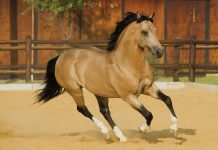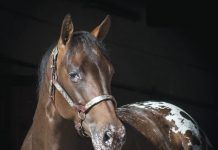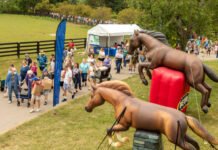When Tennessee resident Chad Crider was 18 he won the 1996 American Quarter Horse Association pole bending world championship; he’s also won the All American Quarter Horse Congress five times in barrel racing and pole bending. For the last ten years Chad’s been training barrel racing and pole bending horses and their riders, including teaching pole bending clinics for world champion barrel racer Martha Josey. Follow his 10 tips to improve your pole bending runs.
“You need to be able to lope a perfect circle before you can do barrels or poles,” Chad says. That’s because a good pole bending horse must bend and listen to your hands and legs. A perfect circle is one that’s perfectly round. Your horse should bend his body to match the arc of your turn. Tip his nose in so that you can see his inside eye—the eye closest to the middle of the circle. If your horse makes the circle smaller than you want, squeeze him with the calf of your inside leg to move him out. If he makes the circle too big, use your outside calf to push him in.
“You need to be able to first walk a perfect circle, and then trot a perfect circle, and then lope,” Chad says. After you’ve mastered perfect circles at all three gaits and in both directions, practice what Chad calls the tornado. Start out riding a small circle, and then spiral out, making your circles bigger and bigger. Next, spiral back in, making your circles smaller and smaller.
2. Practice Running
Besides bending, your horse needs to know how to run, and slow back down and stop when you ask him to. Chad likes to practice these things in a safe place, like a racetrack, large arena or pasture with good footing. If your horse doesn’t listen to you when you tell him to slow down, don’t try it!
Remember, you’re training your horse, so always stay in control. “If you run your horse out in pasture, and you’re racing him all the time, that’s going to make your horse crazy and want to run all the time,” Chad warns. He practices breezing, or running, his horses occasionally, but he doesn’t overdo it.
3. Slow Down
Even though your horse should be able to speed up when you ask him to, like on the straightaway home, going too fast through the pattern itself is the most common error Chad sees. “In the poles your main thing is to be smooth,” he says. “It’s a timed event, but your time will be a lot faster if you slow down and make everything right. If you make one mistake it’s going to cause four or five more. Slow down and make everything smooth.”
Chad also sees riders that try to go fast before they’re experienced enough. “Don’t speed up till you’re ready to speed up. We see a lot of people trying to go fast and trying to win when they’re not ready to. You need to be able to trot a perfect pattern before you can lope a perfect pattern. You need to be able to lope a perfect pattern before you run a perfect pattern. Don’t jump the gun and go too fast.”
4. Think Straight
“People will talk about weaving through the poles,” Chad says. But this is wrong; you don’t want to make big turns in and out of the poles because it will take you too much time. “I don’t really like to say weaving. I like to ride a straight line,” he explains. “I want my horse to stand up straight and barely miss each pole. If I’m going way out, I’ll hit the next pole, so I like to stay as close to them as I can and think about going in a straight line.” Chad says to miss each pole by just inches.
5. Get Your Leg Past the Pole
If you think about getting your leg past each pole, Chad says you won’t tip over as many poles or make such wide turns. “That’s the main thing,” Chad says. “If you ride through the pattern and you think, ‘Don’t go to the next pole until I get my leg past this one,’ then you won’t knock one down.”
6. Use Even Pressure
“Going through the pattern I stay two-handed,” Chad says. Keep an even pressure on both reins. Don’t pull your horse’s head much in either direction as you do the pattern, or your turns will be too big. The end poles are the only turns you’ll need to really bend your horse for.
7. End Turns are Like Barrels
When you turn the end poles of your pattern, you’ll want to hold onto the horn with your outside hand, just like barrel racers do around the barrels. “You want to grab your saddle horn and push on the saddle horn, so you make sure you’re down in the saddle,” Chad says. Hold it so that you palm is on the back of the horn. “If you don’t grab your saddle horn you’re going to get thrown forward,” Chad warns.
Just like in barrel racing, you’ll want to pull straight back toward your hip bone or pant pocket with your inside hand—the hand closest to the pole. This will tip your horse’s nose in, and his body will bend around the pole. Don’t make the mistake of pulling your hand out or down.
8. Stay Still
As you weave the pattern, you should sit up straight in the saddle and stay as still as you can. “You don’t want to lean forward or be kicking a lot or moving, just sitting real still,” Chad says.
If your body and hands are too far forward you’ll only have control of your horse’s head. But if you sit down with your hands right above your horse’s withers, then you’ll have control over his whole body, Chad explains.
9. Stop Hitting Poles
If you’re following all these tips, but your horse still knocks poles down, Chad says using a little more outside rein can help. A lot of people pull too hard, which gives the horse something to brace against—kind of like a tug-o-war. Instead, use just your fingertips when you put pressure on the reins, and try keeping enough feel of your outside rein that your horse doesn’t over bend and hit a pole.
Sometimes horses hit poles because they’re turning too soon. “If I have a horse that hits a lot of poles, I’ll skip every other one,” Chad explains. In other words, practice the pole bending pattern, but only turn every other pole. “If I’m running the pattern and my horse is anticipating or turning too soon, I’ll go straight on past that turn. You want your horse to wait on you and not move until you tell him to move,” Chad says.
10. Practice Right
Another way to practice the pattern and keep your horse on his toes is to go through the poles several times without running out. “I just keep going through the pattern at the walk, trot and lope, and that really teaches the horse,” Chad says. Go through the poles four or five times, and then come out and give your horse a break.
Walking and trotting the pattern is a good way to work on your timing, but don’t practice running the pattern too much once your horse does it well. “After you get your horse finished, and he knows the pattern, you don’t want to overdo it by running everyday,” Chad says.
With the right kind of practice and these tips from a champion, faster pole bending times are just around the corner.






